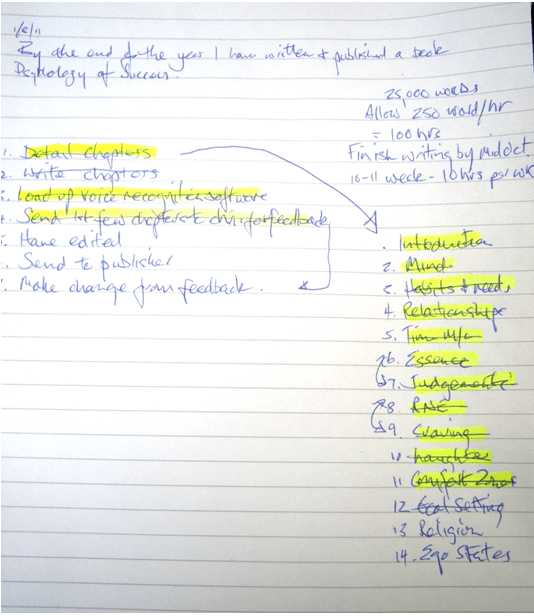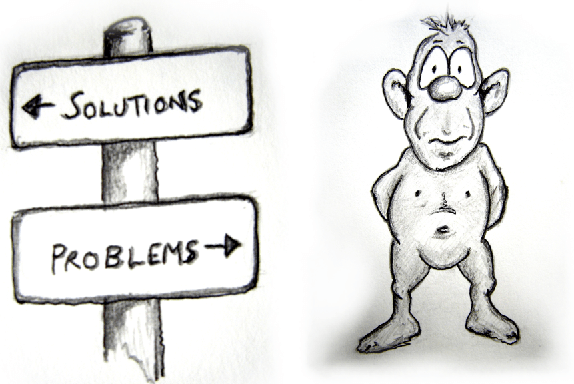
Everything we do comes from a goal set in the subconscious mind.
Walt Disney once said that all dreams come true if you have the courage to pursue them. I always introduce clients to goal setting; it creates a positive expectation of the future – something many people don’t have. Goals motivate, excite and create momentum.
How many dreams have you squandered in your life through lack of action and commitment? We have all had dreams, but often we lose sight of them as the trivialities of day to day existence take us away from pursuing them. These are trivialities for which we often sacrifice our important dreams. These short-term wants takes us away from our long-term aspirations – away from our goals and our dreams. What we will be covering in this chapter are the simple steps of goal setting and time management.
I had a client who worked for IBM. I suggested we look at goal setting and, he told me he had recently done a five day course on goal setting so it was probably pointless. I asked what goals he had been working on since the course and he said he hadn’t developed any yet. I think it might have been a case of too much information. You need to keep things simple for them to be effective and I would be at a loss to cover effective goal setting in more than one hour. I like to keep things simple.
Everything we do is goal orientated; it’s the way the mind works and most goals are designed to meet our needs in some way. Just getting up to make a cup of coffee starts as a goal in the mind. With goal setting, we are looking at setting goals that help us grow. Because of this a goal should be big enough to scare us a little but also excite us a lot. Sometimes it is fear that stops us achieving our goals. Fear of failure can stop us dead in our tracks. Sometimes we just feel overwhelmed by the things we need to do to reach the goal, or the time it will take to reach it. Sometimes we feel that we just don’t have enough time. Well you can’t eat an elephant in a single sitting but you can eat it one bite at a time. Some simple steps can overcome these barriers.
Around 3% of people write down their goals – only 3%. But it has long been recognised that the 3% are the ones most likely to reach their goals.

Working on three to five goals on a continuing basis allows us to achieve the things we would like on a regular basis.
Let’s first look at goals from a business point of view. How far do you think we would get if we said let’s build a 20 storey building over there and not write anything down? How far would we get if we didn’t turn it into a project and plan the activities from design to construction? It might seem ridiculous but that’s exactly what most people do when it comes to their own goals. Your own goals and dreams need to be turned into personal projects – some large projects and some small projects. When you can see your goals as projects, you can plan the activities to accomplish them; you can move them from wishful thinking to reality. I believe that working on three to five goals on a continuing basis allows us to achieve the things we would like on a regular basis.
Let’s again look at the project of building a 20 storey building. The goal first must start in the imagination of someone. If you look around and see all the man-made things your eyes come to rest upon, you can understand that they all started out in someone’s imagination – chairs, computers, cars, cups, clothes and that’s just to name a few! They all started out as someone’s dream. All started out as an imagination that moved to a business project that materialised through planning and activity. In business we can be quite good at allocating time and resources to the bigger projects and yet still not see most of our work time as working on a project time. There should be times for maintenance that can also be a project. If we are not working on projects of growth, then there is a good chance we are stagnating or going backwards.
What is time? Can we actually make time, lose time or buy time? Not really. Time is just a period of measurement. As the earth rotates on its axis, it gives us periods of days, and as it orbits the sun gives us periods of years. All periods of time for humans are psychological time – we created them. We break the days into hours, and the hours into minutes – but it is all created in the minds of people. Some organisms have their own sense of time, such as the corals on the great-barrier reef. They spawn once a year over a two day period – but this is a result of environmental conditions. They don’t follow the human clock. (And they chose to spawn a few days after I spent a week in Queensland waiting to see this marvellous thing happen!)
You can’t manage time; but we can plan time to manage activities. It is a psychological resource – a resource given in the same amount to everyone every day. It’s the activities you choose to perform and the management of these activities within a set time frame that determines whether goals are being achieved. So we can’t make time, but we can take the time we have in this moment to do what’s important. We can take the time to plan and perform activities each day that will move us closer towards our goals.
So, let’s look at the mechanics of goal setting. I believe it was Napoleon Hill in his book Think and grow rich, who first said, ‘what you can conceive and believe; you can achieve.’
So, the goal or dream starts in the imagination as a concept. We start to visualise the finished result. Because the subconscious mind can’t tell the difference between a real or imagined experience, the more we hold the goal in our imagination, the more real it becomes for us. It becomes believable – and when it is believable the subconscious mind moves us towards it, what we believe we will see. Maxwell Maltz wrote a best-selling book called ‘Psycho-Cybernetics’ back in the seventies – psycho being the mind and cybernetics being a guidance system much like we see in a plane or a guided missile. A plane or guided missile may be off target over 95% of the time but it keeps checking progress towards the target and altering direction to suit. When we imagine our goal as realised on an ongoing basis the subconscious mind works the same way. It becomes creative in checking progress and changing direction, if required, to get back on track.

We need to turn the want into an expectation and know we will achieve it.
To make sure we hold the goal in our imagination we need to write it down with a time frame and visualise it frequently. When writing down a goal, always write the goal with a time frame and as though it is already realised – this creates a positive expectation. We don’t want to hold it in our mind as a want. This will just tap into the fear that we may not get what we want. We need to turn the want into an expectation and know we will achieve it. I have a ring binder exercise pad to write down my goals.
I worked with another Psychotherapist as his supervisor. When he first came I mentioned the benefit of giving clients CDs for use between sessions and suggested he would benefit from doing the same. Each month he would come along for supervision and I would ask how his CD was coming along, only to get the same answer: ‘I’ve started the script but haven’t had the time to work on it.’
The following is the way I turned the idea of the CDs into reality. This comes directly from my goal book and it is this simple.
The Goal.
By the end of November I have three new tracks to add to the car CDs.
To Do.
Track name
- Ego states Write script Record
- Attitude Write script Record
- Moment Write script Record
A script for a 15 to 20 minute recording will take me around four hours to write. I will record the three tracks together and allow eight hours for recording, editing and adding music. Total time is twenty hours. I take the ego states script and book two 1 hour sessions in my diary each week for the next two weeks. I scribe a line through this to let me know it is in the diary. At the end of the two weeks this is now complete and is highlighted with a yellow highlighter. The next script is then allocated time in the diary and a line scribed through it. The above example tells me I have two scripts finished and one in progress and I am now looking at booking in the eight hours for recording.
The more yellow I see, the more motivated I become to achieve the end results. This goal was achieved over a seven week period. I write ‘completed’ through the goal when finished and leave a few of these completed goals in the front of my goal book. This tells me each time I open my goal book how good I am at achieving them – simple, but very effective.
It is the same principle for personal or business goals. Holding the goal in the imagination is the first step to achieving it. But our management activities make the difference between achieving a goal and letting it drop off the radar.
Now this is where we need to look at a goal in the same way as a business looks at a large project: with a list of things to do; plus a list of activities that needs to be completed for the goal to be realised. So we put together a ‘to do’ list with all the activities needed to achieve the goal. I always suggest that you have an exercise book where you write down your goals and list the activities to do.
This might be a ‘to do’ list for the person wanting to get fit and lose 5 kg.
- Forty-five minutes of exercise 5 times a week.
- Limiting eating treats to twice a week. Small treat.
- Eating healthy food for all meals. Higher protein lower carbs.
- Two meals open choice. No restrictions on type of food.
- Five alcohol free days a week.
Now we know what to do, we need to schedule when to do it in a diary. Schedule the exercise on five days at the times you plan to do it. Nominate two days when treats are allowed and two open choice meals. Decide when you will have the alcohol-free days and nominate them with an ‘AFD’ in the diary. As this is a repeating schedule it can be duplicated each week in the diary, and in this case the project would run until the end of the year. At that time, you might consider retaining some of the key elements, such as exercise, as a maintenance program. The main thing to recognise is that you must keep the appointments with yourself. You must do what you have recognised you need to do to reach your goal or you will be drifting around the ocean like a ship without a rudder. Once you have scheduled your actions and given them a time-frame during your day, your goal is already realised. You just need to keep these appointments with yourself. But you have to be careful. In will pop the short term wants, ‘I can’t be bothered exercising today, I just want to stay in bed an extra half hour.’ To overcome these wants we need to maintain the desire and motivation to reach the goal. We need to create a belief in its success – a positive expectation of a successful outcome. We need to develop the habit of doing what we need to do.

Your subconscious mind can’t tell the difference between a real or imagined experience.
In the case of this goal, each day you could visualise yourself as being fit and healthy and 5kg lighter, and feel the way you would feel if you were. Feel the way you would feel if it were already realised. It is our imagination, coupled with emotion, which creates the belief. Your subconscious mind can’t tell the difference between a real or imagined experience. You might go through your goals each day and check progress towards them or you may find it suits you to do it once per week when you schedule the activities from your ‘to do’ list, but you should have your goals in your imagination at least once per day to maintain momentum and expected progress towards them.
There is another benefit from scheduling your day in a diary. It frees your mind to live in the moment – to be fully focused on the task at hand and this in turn makes you more efficient. Our minds no longer jump back and forth thinking I have to do this and that – it’s all planned and in the diary or on the ‘to do’ list. And we can also have a daily ‘to do’ list for all those things that crop up from time to time that are not part of our goals.
Sometimes we can begin to feel overwhelmed by all the things we need to do. Listing and scheduling them takes our minds off them. We don’t need to think about them until we do them. One of the most important things to schedule into your diary is a time each week to review your goals.
So let’s review the basics of goal setting and time or activity management.
Firstly, see your goals as personal projects. Write them down with a time frame, and state them as though they are already realised. Have a goal book that you review at least once a week.
Secondly, break the goal down to activities you need to do to reach the goal. A ‘to do’ list.
Thirdly, schedule the activities into a diary and keep these appointments with yourself. Scribe a line through the activity in your goal book when you scheduled it in your diary. Highlight the activity in yellow in the goal book when it finished.
Do what you need to do. Keep these appointments with yourself and just do what you need to do in the moment.
Lastly, visualise them every day as you move towards them. As you do the activities and review them at least once a week, highlight the activities finished and schedule the next activity in your diary.
I see goals as organic and not set in stone. Sometimes goals will change or develop into something else. Let them grow and change if they need to. Below is a photo of my goal sheet with regard to writing this book and you can see in an instant my progress towards my end result; you might also notice the book you are reading had grown with more chapters and words.







